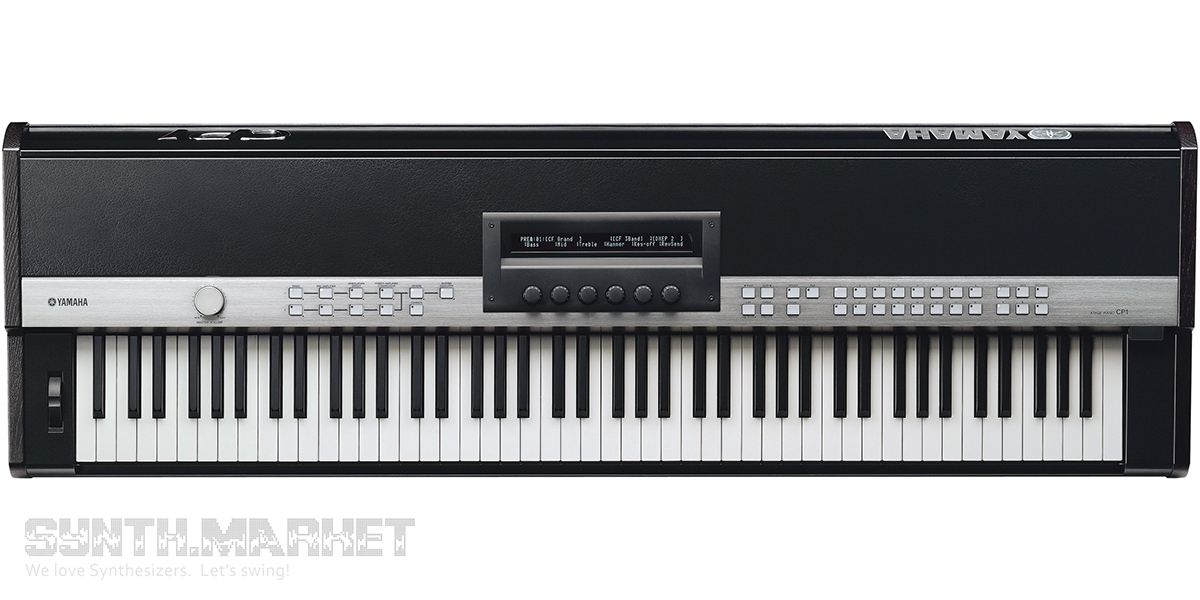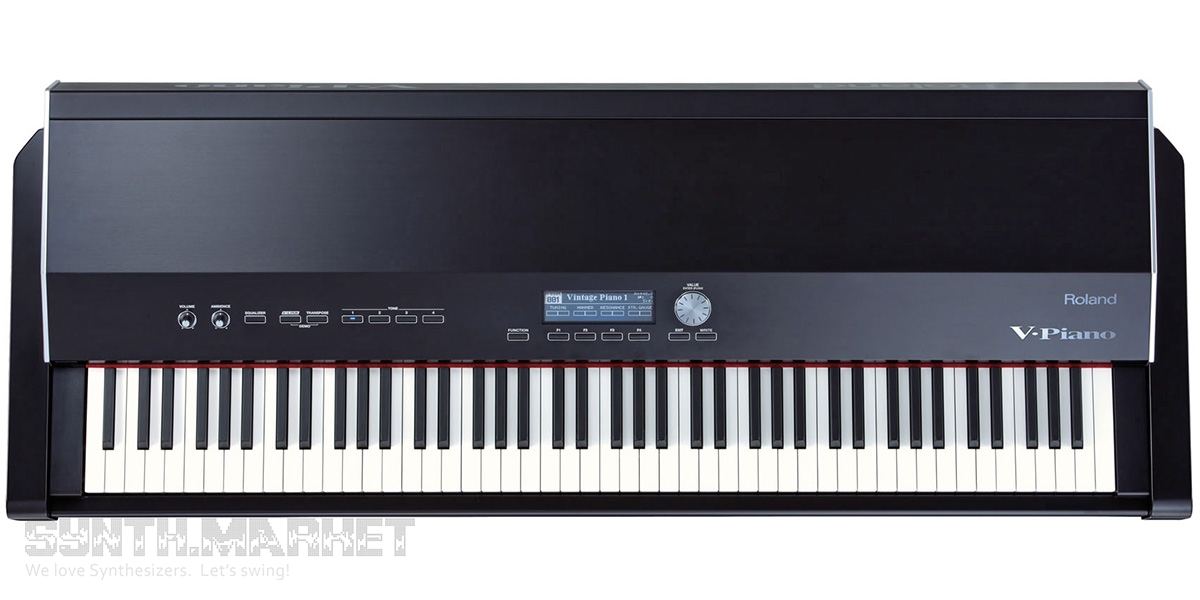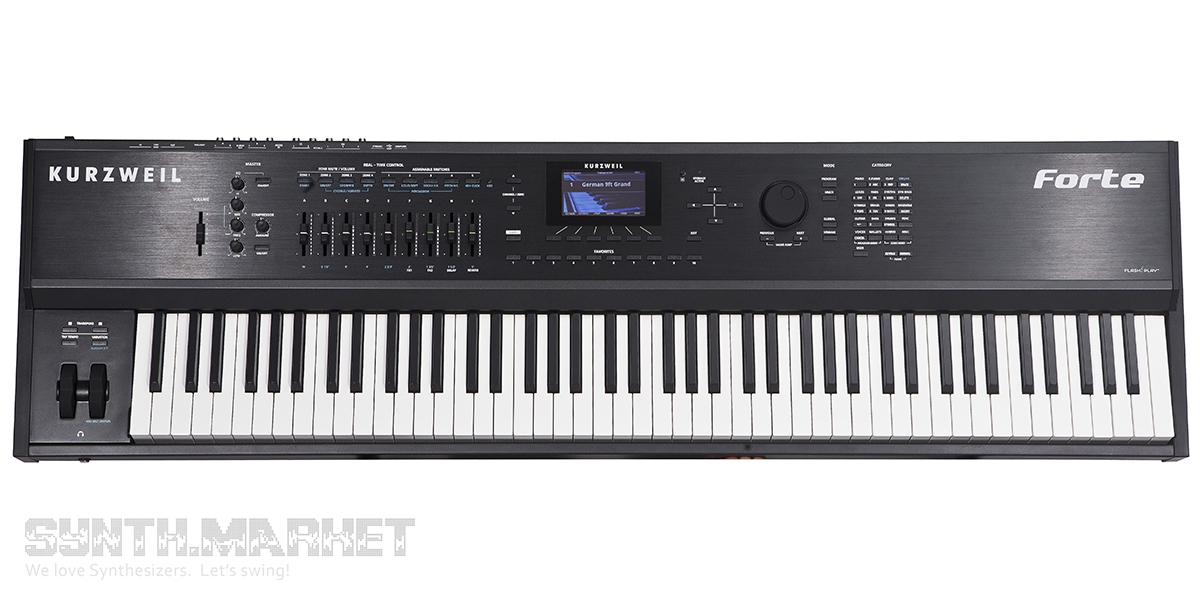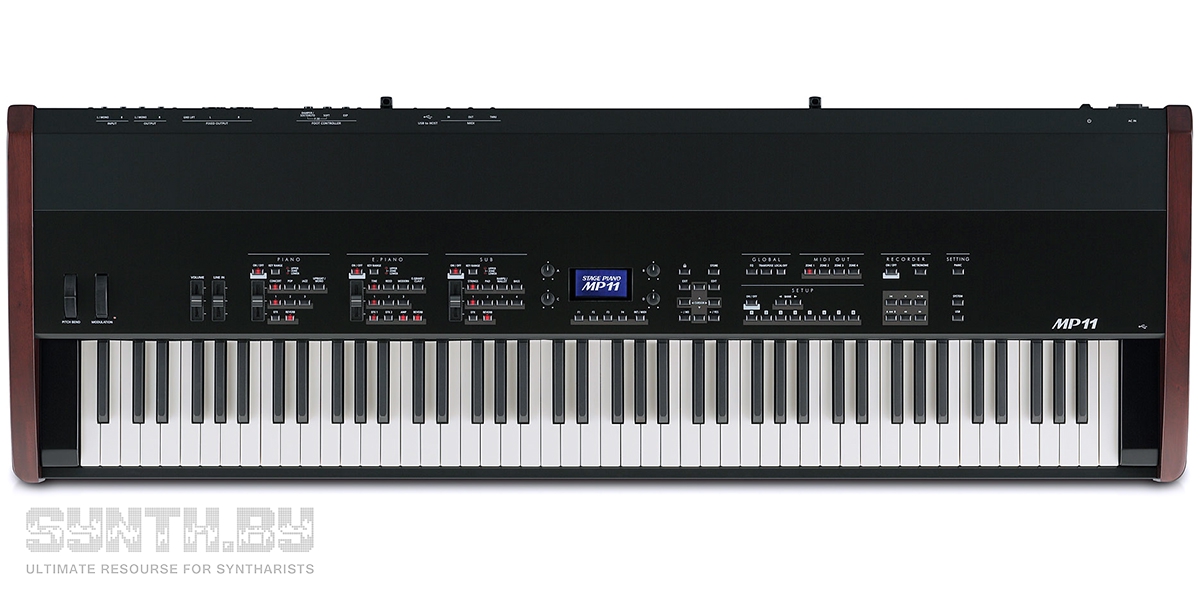Yamaha CP1 combines sampling with modeling technology in order to deliver all the nuances of an acoustic piano. CP1 is bitimbral and offers a comprehensible and easy layering function – simplicity is in the heart of the CP1 concept. Favorite or most essential functions can be assigned to any knob and displayed in performance mode.
CP1 sounds almost perfectly – no perceptible joints or audible sample switching, oscillator response is even and smooth all the way, at any step of the sound making process and in any part of the frequency range. Although CP1 has its own peculiarity: an 88-note fully-weighted NW‑STAGE keys don’t “choke” or “swamp” but seem to react a bit lazily to quick arpeggio; some sounds also lack sparkle and liveliness. Although a 5-band equalizer compensates this seeming spiritlessness if you find the character of CP1 too static or irrelevant. Anyway the instrument offers magnificent voices of CF grand, CP80 and 75 Rhodes.
Yamaha gave to the sound its brand quality leaving us with all the rest – you’re free to tincture it with any shade or nuance you may want. There is a various control possibilities for each piano type starting from hammer stiffness and striking position to adjustable decay for each note. The preamplifier and amp itself will alter any raw sound you put through it.
The signal path is comprehensible thanks to the clever layout of the front panel: piano block offers 17 piano/electric piano modes (a few acoustic + Rhodes and Wurlitzer emulation as well as DX7 which can be fed through preamplifier stages – preamp and speaker copies of Rhodes and Wurlitzer components); modulation block with balanced effects (chorus, phaser, wah, flanger, symphony); amplifier block modeled according to Rhodes and Wurlitzer, also including a vintage compressor with quite an authentic operation manner for sound master processing; reverb block comprises 8 types as well as a detailed equalizer allowing you to control peaks, shelf and “Q” parameters for each band.
If $6000 was a common price for top stage pianos made by top brands and there was no “mid-range” instruments in that category then we wouldn’t be surprised with this value-for-money kind of thing – you take it the way you get it. But there is CP5 – its affordable cousin – which embraces all the fundamental SCM voices, a wide choice of sampled sounds, sequencer and some would even say a friendlier interface. Of course it doesn’t negate all the good features CP1 offers but still this price issue is a little bit bewildering.
A year earlier in 2009 Roland V-Piano was released and went on sale as a $6500 unit – the first standalone instrument based on acoustic piano modeling technology. The architecture of V-Piano doesn’t use samples (which professional pianists were never happy about) but creates the sound from scratch with the only help of digital modeling. The sampling technology relates to the additive synthesis, it doesn’t generate signal in the process, a sample is a capture of a real instrumental voice but not an imitation of the real process during which the sound is produced. Engineers offered a lot of user editing abilities in order to make these captures move and respond: retrigger function, damper noise or string resonance layering, hammer action adjustment and others, but when we talk about acoustic piano we need those real components of a real instrument which can’t be replaced with any of the basic synth functions. Roland modeled each components thinking about their realistic interaction: the harder the hammer strike is the brighter the string harmonics should be. Roland offered a unique innovative and sophisticated technology while Yamaha CP1 provided us with samples – but both ask for the same price! Though we should note that many of the physical modeling technology patents actually belong to Yamaha – in 1994 Yamaha VL1 was released and it was based on the principles of such a technology.
There are two types of the piano models: Vintage which is responsible for real piano sounds and Vanguard which suggests enswathing into physical modeling wilds. Vintage 1 produces a whole, deep sound with an articulate presence which is very important when there are many instrumental voices in the flow. Vintage 2 is a more romantic, kind of soothed and muffled variant. Physical modeling serves to make the sonic flow smooth and soft while samples are a bit more risky part of the deal – we have to take on trust the promises of the engineers who say that they ensure subtle practically intangible stitches between velocity values of two pressed keys. Both of the models offer a few tonal presets - Studio, Concert, Session and Mellow.
«All Silver» Vanguard model replaced standard copper strings with the silver ones which in reality would require adaptation of many other physical components of an acoustic piano. V-Piano implements this much easier and causing fewer problems and headaches delivering a deep, juicy, shimmering voice anyway. Other three models offer three strings per note generating impressive volume and fruitiness.
All the 24 presets V-Piano features can be processed and the results can be saved and stored separately as user presets (up to 100). The piano isn’t laden with controllers; basic functions are easily accessible through the front panel and set you free from the constant turning to the software editor.
PHA-III Progressive Hammer Action weighted 88 keys (with an escapement technology per each note) is so responsible (5 velocity modes) that even makes you imagine the real mechanism touching strings. When you accelerate your playing you may feel that tonal sway intrinsic to a real piano.
Roland V-Piano took it seriously, extremely seriously willing to develop the best acoustic piano in the demanding digital world.
Kurzweil Forte top series synthesizers landed on $3000-4000 – depending on the model. These instruments hit the list of the top pianos thanks to the sound engine of the highest quality and quite imposing samples though actually they belong to another group representing upper mid-range stage pianos and compete with Yamaha CP4, CP5, Roland RD-800 or we might say Nord Stage 2/ Stage 2 EX. Its Fatar keybed is truly multifunctional and aimed at keyboardists but not professional pianists, i.e. it gives way to other instruments in our review.
There are 3 DSP integrated circuits: 2 of them are for the synth engine operation as well as for the effects, the third one is assigned to process KB3 organ sounds.
Forte gives us 16 Gb flash memory (Forte SE – 2 Gb) filled with new samples including the acoustic ones (one of the most prominent upgrades, a few German and Japanese variations), electric Rhodes and Wurlitzer and harpsichords. User sample storing is unavailable due to Flash Play. Presented here Rhodes and Wurly can definitely compete with those produced by CP1 and MP11 and might even win because they seem to sound so authentic.
KB3 modeled with a special attention and approach – as always – as well as with the emphasis on the functions which concern the organ section directly: on the front panel they’re highlighted; reverse polarity sliders function as drawbars; vibrato/chorus, percussion control buttons and Variation button which addresses Leslie speaker simulator. We can claim that this built-in KB3 sounds so good that may be beaten only by a classic organ clone.
Synth sounds present a wide range: curvy leads, evolving pads, intensive bass, compound sounds. Familiar parameters such as cutoff frequency, resonance, attack/release time parameters of the amplitude envelope can be applied in order to fill in the missing sound character.
Forte’s wind section was taken from Kore64 (together with percussion and drum kits) and PC3 series. The strings are based on the K-series designs and sound as real as a key of the top synth ever could. Mainly it’s thanks to an elaborate voice programming and Forte converters.
Forte sports a nice and simple approach to operation modes: layer and split functions don’t carry you away into the depths of Multi editing mode if you’re in Program one and don’t need to go further. Only after the result is saved the new “multi” appears which now can be processed in detail if you want. That’s why Forte as a stage piano has an advantage over workstations – you can easily and quickly get from sounds to the editing. If you press one of the Favorite buttons and wait a little your running program or “multi” will be saved among the others, Kurzweil came up with the Quick Access function long ago.
Forte sounds the way it costs – it’s not overpriced due to innovative technologies use and it’s not underrated by the company as well: they ask for what they give. Kawai MP11 is cheaper but offers fewer non-key voices so it’s not as multipurpose as Forte is (samples, modeled tonewheel organ, virtual analog synth waveforms).
Anyway Kawai has its own indisputable advantages – price/quality proportion seems to be right and quite luring here. A 256-voice polyphony of Kawai MP11 is unswerving even if all the 3 oscillators operate simultaneously. Harmonic Imaging technology was acting smart with Kawai EX Concert piano material first making stereo samples of each note and then twirling them back together while doubling the sources directed at the attack segment – a critical component of realistic sound perception. Virtual Technician is one of the unique and most useful aspects of MP11 which addresses even subtle details allowing users to control and alter the sounds any way they seem appropriate. So it features multifunctional editing which includes: 7 variations (equal, pure major/minor, Pythagorean, mean tone, Werckmeister, and Kirnberger), 2 user variants per note, standard cutoff frequency, resonance and ADSR modeling the sample set (which can be saturated with parameter settings and layering). To make basic samples “cross the line” you can use some voice, bell or air samples. The metronome allows carrying up to 10 settings though you can also put to use 100 drum patterns.
6 thoroughly developed adjustable reverbs (Room, Lounge, 3 Hall types and Cathedral) are accompanied by 129 effects each of which offers up to 10 editable parameters and after you can go to settings control of the 5 amp simulation types. Reverbs and equalizer can be applied individually or globally.
Kawai MP11 features Grand Feel keybed with wooden keys of a gradual action (heavier in the low). To make it complete it would be great to have a mechanical vibration which was not devised by Kawai in order not to overdo with the size and complexity as well. Many professional musicians believe it’s the best keyboard in its category.
We should note that Roland V-Piano and Yamaha CP1 are first of all parametrical competitors of the unfailing and splendid sounding MP11 while Kawai should be noted first of all as the most affordable unit of all. Moreover, all of the abovementioned instruments made by the Japanese companies are sort of one-purpose (dedicated to the pianists or at least to professional keyboardists) digital pianos of the highest possible class which don’t feature to many other sounds but the keys, yes, they offer enough of piano types. So if you need a multifunctional instrument with the best sound one can get for live solo or ensemble performances – focus on Kurzweil Forte, this stage piano features much more sound programs than others or read the article where we reviewed mid-range stage pianos which will definitely suit any multi-instrumentalist.




